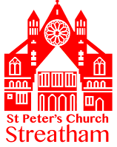Two South London Organs by W.L. Sumner
Reproduced with kind permission of the editors from Musical Opinion Magazine: Published February 1970
The Church of St. Peter, Leigham Court Road, Streatham
“Few “untouched” large Hill organs now remain. It is more than half a century since the Hill firm amalgamated with, and was later absorbed by, that of Norman & Beard.
Most of the instruments of the original firm have been rebuilt. The large organ in All Hallows, Gospel Oak, and the four-manual, which formerly stood in the Northern Polytechnic Institute, Holloway Road, now in the Catholic Church, near the top of Highgate Hill, still remain to us. The large organ, which used to stand in the little church of St. Mary the Boltons, Kensington, has been transferred, with some modifications, to the great parish church of Yarmouth, where it replaces the late J. J. Binns’s largest instrument, destroyed in the war.
The four-manual Hill in the Church of St. Peter (formerly known as. St. Peter and St. Paul [See note*]), Streatham, is worthy of sympathetic restoration. Although the church lost most of its stained glass in the war, the organ was little damaged. In its life of nearly 70 years it has received little attention, apart from routine maintenance. The fact that it functions as well as it does, and is still unmistakably a musical instrument, testifies to the workmanship and quality of materials which went into its making. The solid plates of ivory, 1/8in. thick, of its manual keys are not much worn, even on the great manual [See note**].
The church, on a hillside near the top of Leigham Court Road, Streatham, commands a view over a considerable part of South London.”
“The great organ chorus of diapasons and upper work is typically Hill’s: it is bright, transparent; unexaggerated, and fills the church with a gentle fullness and brilliance. The gamba is a small open diapason of bright but not incisive tone. The stopped diapason is a gem and the so-called Wald flute, a speciality of its makers, is pleasing. The trumpet and clarion do not engulf the flue tone. Such a great organ steers its way between the overwhelming flue brilliance of the Schulze School and the reedy ensemble of the Willis. The Swell organ is remarkable for its size. Even the Bourdon has its uses, when it is played an octave higher with other soft stops. There is a good diapason chorus in this division; and this offers possibilities for the playing of Bach, which are not to be found in the choir organ. The full swell is “free” in tone, and the blend of reeds and flue work is very good. All the individual registers of the choir organ are good, although the vox humana shows signs of its age. This division should be recast as a positive, organ, and made positive in more senses than one! The Solo organ stops are good. The tuba is of moderately loud trumpet tone, and I prefer it that way.
On the pedal organ, some of the ranks, already extended to 8 ft. pitch, could go further, and add to the independence of the section and its value for sustaining a Solo line of melody. The trombone does not carry all away with it: it blends well with the flue work. The bourdon, which is very regular and without “chiff” in its tone, is quiet enough to be used with very soft combinations. The violone is excellent.”
Sumner goes on to review the fine Harrison and Harrison 3-manual instrument at All Saints’ Church, Tooting Graveney, S.W.I7, and concludes:
“Here, then, are two organs, one of which, when I last saw it, was in need of restoration [See note ***]. They are in walking distance of one another. They are not as well-known as they ought to be. If they were in a suburb of Paris, Vienna, Amsterdam or Brussels, would there not be pilgrimages to see them?”
Notes:
* Unknowingly, Sumner refers to the original consecration to St Peter and St Paul of the temporary church which stood on the opposite side of Leigham Court Road until the new church was built in 1870.
** The original manuals were removed in 1972 when restoration to the manual actions took place. So sadly, the solid plates of ivory cannot now be seen. The last reference to the original keyboard, was that it was stored in the loft of the organ builder Bishop’s.
*** Almost certainly St Peter’s!!

